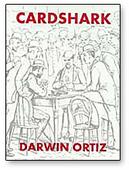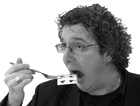Cardshark
Ortiz, Darwin
(Based on 1 review)

Contents:
- Introduction (Paul Gertner)
- Foreword
- Part One: Impromptu Miracles
- Part Two: Presentational Showpieces
- Part Three: Gambling Routines
Reviews
(Top ▲)
The difference between a book like Darwin Ortiz’s Cardshark and J.K. Hartman’s Card Craft (for example) is one of purpose. Cardshark is a collection of card magic conceived of and performed by a professional. The material demonstrates constant vigilence towards engaging, commanding and fooling real-world audiences.
Books like Hartman’s Card Craft, on the other hand, contain an abundance of material that, while creative, has not been imbued with the depth that can only come from repeated performances for paying audiences. It is good material, to be sure (I enjoyed the book immensely), but it satisfies a different part of the brain – the same part that craves the latest palm-pilot, or a new Tenyo trick, or a trip through the dealer’s room at a magic convention.
Indeed, one of my favorite tricks in Cardshark ("Blind Aces") is a presentation for J.K. Hartman’s "Uppercutting the Aces" (from Card Craft) that elevates the simple cutting-to-the-aces routine into a powerful and memorable showpiece.
Published in 1995, Cardshark contains 30 routines that range in difficulty from intermediate to advanced, but the methods employed, whether "easy" or "hard," always serve the larger purpose of building the cleanest, most entertaining effect possible.
However, while the plots are all clear and direct, very few of them are quick. Most will require an audience that’s attentive from the start (particularly the ten gambling routines in chapter three), which rules out more "hostile" performing environments, such as bars. In addition, every trick but five requires the use of a table, which limits the material’s usefulness in walkaround work (though in some cases, a spectator’s hand could be used in place of the table).
All of this makes sense, of course, when you consider the source, a gentleman who, at this point in his career, performs primarily while seated for audiences who have essentially come to see him. I say this not to disparage the contents of the book - it is filled with excellent card magic. I just think it’s important for the buyer to understand where the material will fit into his own repertoire, if at all.
Among the highlights for me:
I’ve singled out a handful of routines that spoke to me during my first read-through of the book, but I suspect I will discover more gems the next time around. Fans of Mr. Ortiz’s wonderful At The Card Table, or books like The Secrets of Bro. Hamman will enjoy Cardshark too!
David Acer
Books like Hartman’s Card Craft, on the other hand, contain an abundance of material that, while creative, has not been imbued with the depth that can only come from repeated performances for paying audiences. It is good material, to be sure (I enjoyed the book immensely), but it satisfies a different part of the brain – the same part that craves the latest palm-pilot, or a new Tenyo trick, or a trip through the dealer’s room at a magic convention.
Indeed, one of my favorite tricks in Cardshark ("Blind Aces") is a presentation for J.K. Hartman’s "Uppercutting the Aces" (from Card Craft) that elevates the simple cutting-to-the-aces routine into a powerful and memorable showpiece.
Published in 1995, Cardshark contains 30 routines that range in difficulty from intermediate to advanced, but the methods employed, whether "easy" or "hard," always serve the larger purpose of building the cleanest, most entertaining effect possible.
However, while the plots are all clear and direct, very few of them are quick. Most will require an audience that’s attentive from the start (particularly the ten gambling routines in chapter three), which rules out more "hostile" performing environments, such as bars. In addition, every trick but five requires the use of a table, which limits the material’s usefulness in walkaround work (though in some cases, a spectator’s hand could be used in place of the table).
All of this makes sense, of course, when you consider the source, a gentleman who, at this point in his career, performs primarily while seated for audiences who have essentially come to see him. I say this not to disparage the contents of the book - it is filled with excellent card magic. I just think it’s important for the buyer to understand where the material will fit into his own repertoire, if at all.
Among the highlights for me:
- "Blockbuster," a novel effect in which every card that is the same color as a freely chosen card suddenly turns face up in the face-down deck, except for the selection. The reveal is particularly nice here because, once the deck is spread, showing, say, all the red cards face up and interlaced between the face-down black cards, it is then immediately turned over, showing all the black cards face up, with one red card in the middle - the selection!
- "Against All Odds," an interesting coincidence effect in which a card is freely chosen from a deck in new-deck order, then the pack is cut several times by a spectator while the magician explains that this does not destroy the sequential set-up, though it does change the position of the cards. The spectator then returns her selection to the pack, whereupon it is found to have been replaced in its correct sequential position!
- "The Marker," an ingenious approach to Paul LePaul’s torn-and-restored card and one of the best motivated effects of its kind.
- "Time and Again," a multi-phase routine in which a new deck of cards is introduced, unsealed and shuffled, then a spectator writes the time on the back of a joker, which he holds under his hand. Finally, the top card of the deck is shown, then inserted into the middle of the pack, whereupon, one by one, the result of each of these actions is erased, as the deck is sent further and further back in time.
- "Blind Aces," in which a spectator shuffles the deck, then another spectator stands behind you and covers your eyes, whereupon you take the deck and cut to the four Aces, one after the other (with a twist on the final Ace). From a performer’s stand-point, this is my favourite trick in the book, as the "human blindfold" approach makes for an emotionally engaging, visually arresting presentation.
I’ve singled out a handful of routines that spoke to me during my first read-through of the book, but I suspect I will discover more gems the next time around. Fans of Mr. Ortiz’s wonderful At The Card Table, or books like The Secrets of Bro. Hamman will enjoy Cardshark too!
David Acer



